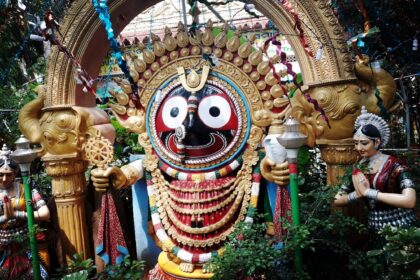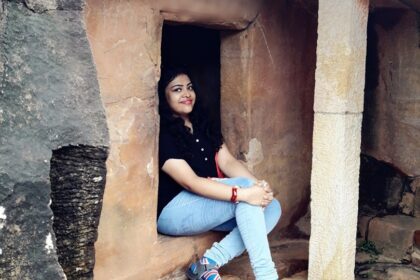CHAUSATHI YOGINI TEMPLE (HIRAPUR)

My native Odisha has so much to offer to curious tourists who seek to unfold new mysteries. One such mysterious location is the Chausathi Yogini Temple at Hirapur, near Bhubaneswar. What makes this temple unique is that it’s the first 64 Yogini Temple in India and from here it spread to other states. And, it’s the smallest temple among the list of four major surviving 64 Yogini Temples in India(in fact in the world), among which two are in Odisha, at Ranipur-Jharial, Balangir, and Hirapur, Bhubaneswar. The rest two are at Khajuraho and Jabalpur in Madhya Pradesh.

This beautiful yet mystic site of ancient tantric practices was visited by me in January of 2020. For me, it was a long wait to visit this first Chausathi Yogini temple. As luck would have it, I visited the two temples at a gap of 18 days, and what a contrast both temples are. One is located next to a huge water tank (Ranipur-Jharial) and another (Hirapur) in the middle of rice-fields on the outskirts of Bhubaneshwar in Odisha.
According to the words of the Chief Priest :

Construction of the Temple took place somewhere in 9th CE with a broad range of 8-10th CE. The temple has been in practice by the local villagers. It was discovered by the legendary Kedarnath Mahapatra of Odisha State Museum in 1953. Since then, it has been under the Archaeological Survey of India.
The temple is believed to be built by Queen Hiradevi of Bhauma dynasty, a dynasty that gave many queen rulers. In fact, the village that has this temple is called Hirapur after the queen. The temple is locally called Mahamaya Temple, after the central deity.
What are the Yoginis?

Yoginis are goddesses or demi-goddesses who are worshiped in Tantric practices. Their temples are usually found with a group of 64 of them. The yoginis are depicted in the form of chakra, and probably that is why their temples are built in a chakra or a wheel formation. Each yogini sits on a spoke of this wheel.

The list of Yoginis is quite different at each temple. Each one of them has a particular name by which they are identified, but no two temples have a similar list. This tells us that the local influences must have dictated the choice of yoginis for a temple. Some of them are benevolent and some of them are fierce. Each of them has certain powers. People worship the one who can fulfill their wish, which could be anywhere from getting a child to destroying an enemy.

Each of the Yogini figures is beautifully carved with a graceful body, elaborate hairdo, a pose that matches her name on top of the animal associated with her. All the 64 yoginis have been depicted wearing necklaces, garlands, armlets, bangles, anklets, earrings and other ornaments. Some of the Yoginis of the temple have also been portrayed as huntresses with bows and arrows, whereas others balancing on a pair of wheels, or playing drums. Some of them have animal heads like Varahi or Ganeshi but they still exude the feminine charm yoginis are known for. Ganeshi, a female form of Ganesha, right with an elephant head is a unique yogini here.

The architecture of The Temple
It is a small circular temple. It is built in local sandstone with the sculpture of the deities in black granite. They are small, contained, focused, and meant for its small population of followers. The architecture of Yogini temples bears no resemblance to the other temples. So, though it is in Odisha, we can’t really call it Kalingan architecture. It’s a category of its own.

Mahadev Temple
A small Mahadev (Lord Shiva) temple called ‘Sankateshwar’ in white color stands close to the entrance of the temple complex. A beautiful little Nandi in white is wrapped in a colorful scarf.

HOW CAN I GET THERE?
- Hirapur is about 10 KM from Bhubaneshwar Railway Station.
- Temple is maintained by ASI, but the local priest takes care of the worship.
- It is open from 6 AM – 7 PM. Evening Arti takes place just before the closing of the temple.
- Early morning is the best time to visit the temple. Days would be too hot. You can avoid a rainy day if possible.
- There is no entrance fee. What you offer or not at the temple is your choice.
- Trip duration – 1 Hour
- Place location – Hirapur, Bhubaneswar, Odisha
- Transportation Options – Cab / Auto Rickshaw


It is really amazing knowing the unknown facts of historical places through yours dimension. I feel so happy reading these feeds. The photos posted in this blog are also outstanding. I really appreciate this way of educating people including me. Your words make these places more beautiful. 😍
Thank you so much for your appreciation and noble words. Really means a lot.😍❤
My memory is rekindled.Dear blogger ,you took me back to those ancient times ,when Devi Upasana and Tantrik practices were prevalent in this land of glorious art.My mind,soul and heart got drenched with spiritual energy as if I don’t belong to the present times, and I travelled back both in time and space to that mysterious past.Marvellous write up.You deserve the full credit for it.👌👌👌
Thanks a lot for your kind words. 🙏😍